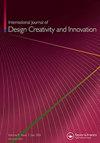平面设计师如何依靠直觉作为一种短暂的工具来支持他们的创意设计过程
IF 2.5
Q4 ENGINEERING, MANUFACTURING
International Journal of Design Creativity and Innovation
Pub Date : 2021-07-08
DOI:10.1080/21650349.2021.1951358
引用次数: 6
摘要
摘要平面设计是一种专门的创造性实践形式,在这种实践中,图像、印刷、文本、形状和其他视觉元素被创造、选择、发展和整合,形成一个连贯的整体,传达预期的信息和用户体验。轶事证据表明,直觉在这一实践中至关重要,但平面设计师究竟是如何依靠直觉来支持他们的创意设计过程的,人们还知之甚少。通过文化调查和半结构化访谈,这项定性研究证明了12名专业平面设计师是如何依赖直觉的,我们称之为短暂的设施。直觉被认为是一种短暂进入意识并强化正在进行的非意识决策的感觉,或导致向有意识推理策略的转变。该研究报告了平面设计师如何在整个创意设计过程中运用直觉——从客户那里获得和选择信息,填补信息空白,设想出发点,并指导开发设计所需的后续行动和评估。这为直觉在推进创意平面设计过程中的作用和相关性提供了新的基于经验的见解,包括其中的社会和物质互动。本文章由计算机程序翻译,如有差异,请以英文原文为准。
How graphic designers rely on intuition as an ephemeral facility to support their creative design process
ABSTRACT Graphic design is a specialized form of creative practice in which images, typography, texts, shapes and other visual elements are created, selected, developed and integrated to form a coherent whole that conveys an intended message and user experience. Anecdotal evidence suggests that intuition is critical in this practice, but exactly how graphic designers rely on their intuition to support their creative design process is poorly understood. Using cultural probes and semi-structured interviews, this qualitative study evidences how twelve professional graphic designers relied on intuition as what we will call an ephemeral facility. Intuition was discerned as a feeling that briefly enters into consciousness and reinforces ongoing, nonconscious decision making, or causes a shift toward conscious reasoning strategies. The study reports how the graphic designers applied intuition throughout their creative design process––for obtaining and selecting information from clients, filling in informational gaps, envisioning a starting point and guiding subsequent actions and evaluations necessary for developing the design. This offers new empirically based insight into the role and relevance of intuition for progressing the creative graphic design process, including the social and material interactions therein.
求助全文
通过发布文献求助,成功后即可免费获取论文全文。
去求助
来源期刊

International Journal of Design Creativity and Innovation
ENGINEERING, MANUFACTURING-
CiteScore
3.80
自引率
27.80%
发文量
15
期刊介绍:
The International Journal of Design Creativity and Innovation is an international publication that provides a forum for discussing the nature and potential of creativity and innovation in design from both theoretical and practical perspectives. Design creativity and innovation is truly an interdisciplinary academic research field that will interest and stimulate researchers of engineering design, industrial design, architecture, art, and similar areas. The journal aims to not only promote existing research disciplines but also pioneer a new one that lies in the intermediate area between the domains of systems engineering, information technology, computer science, social science, artificial intelligence, cognitive science, psychology, philosophy, linguistics, and related fields. The journal covers, but is not restricted to, the following topics: ·Theories on Design Creativity and Innovation ·Cognition of Design Creativity ·Innovative Process ·Inventive Process ·Analogical Reasoning for Design Creativity and Innovation ·Design Synthesis ·Method and Tools for Design Creativity and Innovation ·Representation of Design Creativity and Innovation ·Education for Design Creativity and Innovation ·Concept Generation and Inspiration.
 求助内容:
求助内容: 应助结果提醒方式:
应助结果提醒方式:


